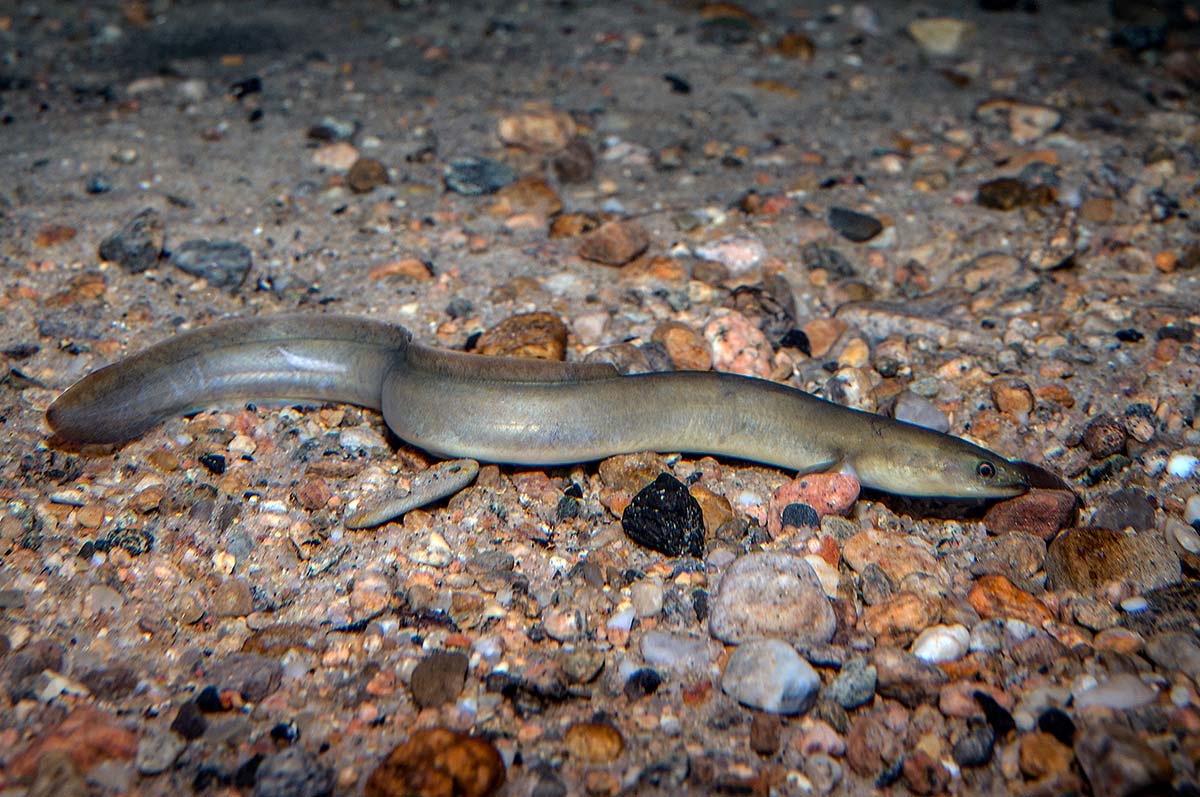
These fish will have traveled close to 3,000 miles by the time they complete their life history!
The American eel (Anguilla rostrate) is not an eel as the name implies, but a true fish. This species of fish is catadromous – a fish that spends its entire adult life in freshwater, then migrates out into the ocean to reproduce. They undergo five different phases of development and move through several different habitats during their lifetime.
My first encounter with this species took place innocently enough while scuba diving Hathaway Pond in Barnstable on Cape Cod. I was swimming over a weed covered bottom, when all of a sudden a large eel approached me and wrapped her entire body around my right leg. This fish was between 3 to 4 feet in length and did not want to go away! Needless to say, at an early age I received a lesson on what a large female American eel looks like up close and personal and have never forgotten.
The American eel is the only species of freshwater eel found in North America. Some researchers believe the American eel to have some of the most diverse habitats of any fish found on the planet. This species of eel hatches in the open ocean waters of the Sargasso Sea, some 2 million square miles of warm water in the North Atlantic between the West Indies and the Azores. This snake-like fish uses prevailing ocean currents to move from where they were deposited as eggs to find freshwater homes anywhere ranging from Greenland south to Brazil.
During their life history, this species will change habitats and move through several phases of development called metamorphoses. The American eel starts and ends its life in the Sargasso Sea. Every winter, mature adult American eels return to spawn in these waters. The exact location is still unknown. Eels gather here from across the species’ range, including fish from Greenland down to South America. This behavior shows researchers that there is a single breeding population of the American eel.
As adults, American eels that grow up to 2 feet in length are male, and those ranging between 2 to 5 feet long are usually female. After fertilization, the eel eggs will float to the ocean surface and hatch into small, transparent larvae shaped like willow leaves seen on trees. The larvae drift in with the Gulf Stream and other regional currents, taking about a year to reach the Atlantic coast. At this early life stage, the eels are called a leptocephali. By the time they reach the coast, the larvae have developed fins and the shape of adult eels, but are perfectly clear with no pigmentation visible in the body. In this phase, you young eels are known as glass eels, and are about 2 to 3 inches in length.
These young eels are called elvers. These eels migrate to brackish waters and begin to develop gray to green-brown pigmentation. Many elvers have been known to move to inland habitats through tidal rivers, while some stay in estuaries with brackish waters or in pure marine waters. This phase includes all eels that reached more than 4 inches in length.
Before the final stage of development, they become yellow eels, which are sexually immature adults that are actually yellow-green to olive-brown in coloration. In their yellow phase, American eels are nocturnal, swimming and feeding only at night. In freshwater, they find homes in streams, lakes, ponds and rivers, particularly where they can hide under logs and rocks. After 3 to 4 or more years of living in freshwater, brackish waters, or marine waters, the yellow eels begin to sexually mature. This is typically when they’re 8 to 10 inches in length. Usually, eels that remain in estuarine and marine waters undergo the same changes but mature earlier than those that live exclusively in freshwater.
Depending on a variety of factors, which can include population density, eel growth rate, and water salinity, they become male or female silver eels with dark coloring, bronze-black colored backs and silver bottoms. Female American eels can grow to 5 feet in length, and males usually reach about 2 to 3 feet. At this point they are called silver eels. Silver eels are sexually mature as they return to the Sargasso Sea to spawn. They undergo some amazing physical changes which allow them to survive in the ocean, changing the eels from shallow water, bottom dwellers to open ocean travelers. These fish will have traveled close to 3,000 miles by the time they complete their life history!
When they get back to the Sargasso Sea, females will release 20 to 30 million eggs that are fertilized by males. Each egg is tiny and only measures between 2 to 3 millimeters in diameter and are perfectly clear when fertilized. Once they spawn, scientists speculate that the adult eels die, but little is known about this behavior and spawning has never been documented in the wild.




